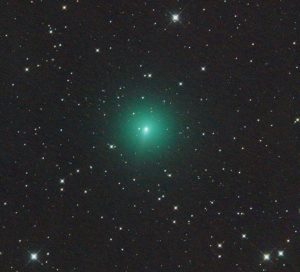I no longer know what day of the week it is. I have friends and family across the street, or right upstairs, that I haven’t seen in weeks. My wife and children (and dog) are here with me, and for that I’m grateful. I know that others are experiencing terrible loneliness right now. That started me thinking about comets.

Comets, along with asteroids, are the little bits left over after the planets of our solar system formed 4.5 billion years ago. Asteroids are mostly rock and metal. Comets are “dirty snowballs”: mostly ice, with rocks, dust, and other frozen elements mixed in. They typically range in size from half a mile to 12 miles in diameter.
So why does lockdown make me think of comets? Because they are the loneliest members of our solar system family. Here in the inner solar system where Earth orbits, planets are relatively close together — sharing the astronomical equivalent of a bustling urban neighborhood. At just about any time of the year, one of our planetary neighbors will be a bright star in the night sky. Last month, Venus was the one to watch.
In the outer solar system, beyond Mars and the asteroid belt, distances between planets increase greatly. But the giant planets that live out there, like Jupiter and Saturn, have many moons, or as astronomers call them, natural satellites. They’re never alone.
Then there are comets. Most orbit in the distant reaches of the solar system, way off the grid. They are so far from the Sun that if you stood on their surface and looked up, the Sun would appear like a star, no brighter than any other. Their orbits span hundreds, thousands, or even millions of years. In the frigid dark, they are billions or trillions of miles from their nearest neighbor. It’s the ultimate in social distancing.
But things are not always so bleak. These long orbits can be highly elongated, so that for a brief period of time in its orbit, a comet makes a dash through the inner solar system, whips around the Sun, then returns to the outback for another loop. As comets approach the Sun and warm up, the ice they’re made of starts to sublimate (convert from solid to gas). Sunlight reflects off the escaping vapors and tiny pieces of ice and rock, and creates a glowing halo around the comet, and sometimes a streaming tail, which is when we tend to take notice. Which brings me, at last, to the comets C/2019 Y4 ATLAS and PanSTARRS T2, the two most recent comets to swing by. Their snappy names derive from the automated telescope systems that found them.
ATLAS has just rounded the Sun and is beginning its long run out. It won’t be back for 25 million years. Earlier in 2020, ATLAS showed signs of developing into a brilliant comet visible to the naked eye. This got picked up by mainstream news, and you might have heard about it. Then it became clear it had broken apart into large fragments, as dirty snowballs often do in warm sunlight. ATLAS will not be putting on a show.
T2 is currently still approaching the Sun. It remains intact, and although it won’t brighten to naked-eye visibility, if you have binoculars, you can see it through May and June. It will look like a fuzzy blob, quite distinct from the bright pinpoints of stars. It’s moving fast, and its position will change slightly from night to night. The best way to find it is with the help of an online planetarium, which will show you where it will be on any given night.
I hope ATLAS and T2 have Netflix and Zoom accounts. We won’t be seeing them again for a long, long time. Clear skies!
